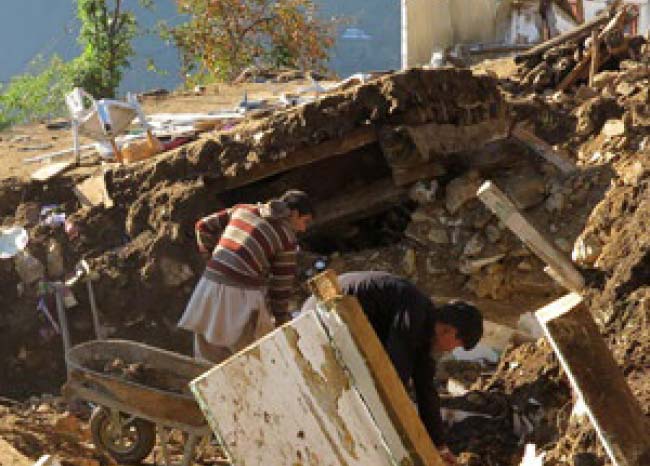FAIZABAD/ASADABAD - Quake-stricken villagers in Afghanistan have been doing their best to help themselves while waiting relief from aid agencies since the devastating 7.5-magnitude earthquake struck parts of the country on Oct. 26.
"Up to 15 districts of eastern Kunar province had been affected by the quake. Dozens of rough roads were blocked by landslides. No army machinery arrived due to insecurity and difficult terrain. Local residents are trying to reopen roads by shovels after local officials promised to pay them cash," Mohammad Habid, a resident of Kunar, told Xinhua.
The quake with a depth of 210 km hit the Hindu Kush mountain range in northern Afghanistan on Monday, with strong tremors felt in Pakistan and India.
The natural disaster, which struck nine out of the country's 34 provinces, had left homeless hundreds of people and displaced thousands of families, victims in many worst-hit areas are waiting for more help.
"As of Friday, the government assessment teams and rescue personnel have failed to reach all affected districts in Kunar. The quake destroyed scores of houses. Villagers are staying in open spaces amid fears of aftershocks. They are in urgent need of food and warm clothes. The weather is very cold during the night. We also need food and blankets," Habid added.
"People in remote areas are digging debris to find remnants of food for children. The Afghan Red Crescent Society (ARCS) was the first and the only aid group to arrive in parts of Kunar and neighboring Nangarhar province. The ARCS also distributed some aid packages provided by Qatar Red Crescent," he said.
The government is leading assessment and response efforts. With the approach of winter, the immediate concerns and needs will most likely consist of emergency shelter, tents, blankets, water and sanitation support.
Assessments to determine loss of life and property damage continued in quake-struck areas in Afghanistan, the UN Office for Coordination of Humanitarian Affairs (OCHA) said.
"Under the auspices of Provincial Disaster Management Committees, joint rapid assessments have now been able to verify the complete destruction of 2,419 houses with a further 2,445 houses severely damaged. Further assessments are ongoing in all earthquake affected provinces, including via the use of the Operational Satellite Applications Programme of the UN Institute for Training and Research (UNITAR-UNOSAT) which is conducting damage assessments using before and after satellite imagery of the earthquake," the OCHA said in a statement.
At least 115 people lost their lives and 556 wounded in the disaster, according to latest data provided by officials. A total of 7,630 homes, 12 schools, 17 mosques, 20 office buildings have been confirmed destroyed or severely damaged by the incident.
"The Government reportedly has released 50 million afghani (7.7 million U.S. dollars) for the emergency response, including for the provision of food rations and logistical support. Humanitarian partners, meanwhile, are supporting rapid assessment activities and have begun responding to immediate needs for food, health, temporary shelter and non-food items. With winter approaching, and the onset of extreme winter weather as early as the end of November in some quake-affected areas, emergency shelter and winterization are particularly pressing concerns to be addressed," OCHA's statement said.
Access to quake-affected areas continues to be a significant disaster response challenge due to the rugged topography and insecurity in the most severely-affected parts of the country such as Badakhshan, Nuristan, Takhar and Kunar provinces.
"The Jurm district of Badakhshan is the center of the devastating earthquake. But no one paid attention to this district. Local leaders said at least 13 people remained under the rubble. The villagers are digging in destroyed houses. They are trying to find and rescue victims. There are no machinery or rescue specialists at outer sides of the district. People are using shovel and simple tools to look after the victims. The villagers set up small groups to travel in remote areas on animals to search and rescue their helpless countrymen. They are also carrying aid packages collected by locals to deliver to needy victims in far-flung areas," a Jurm resident, Mirza Mohammad, told Xinhua via phone.
"We feel relieved. The quake which lasted for roughly one minute and half created panic among the people who rushed out. Fortunately, the quake started with weak tremor which gave a chance for many people to leave their compounds to safer areas," he said.
"Badakhshan is a mountainous province. It has a harsh winter, if the government and aid agencies fail to give a timely response to the situation, hundreds of lives would be lost, we will lose children and women," Mohammad said.
"The government will provide temporary and permanent assistance for the quake-hit families to rebuild their houses. Since the winter is drawing near, if the rebuilding takes longer time, the government plans to provide cash for people homeless and displaced families to rent a house in nearby villages or towns for next three months," State Minister for Disaster Management and Response Wais Barmak told the parliament on Wednesday.
On Tuesday, the government paid 50,000 afghani (781 U.S. dollars) as compensation for every family of 11 school girls, who were killed as a result of a quake-triggered stampede at a school in northern Takhar province. (Xinhua)

